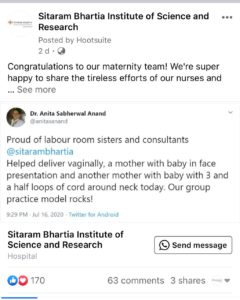Although a c section delivery can be a life-saving operation, it is required only for a small number of women.
In 2016, our staff gynecologist unit demonstrated this by achieving a normal delivery rate of 88% for first-birth low-risk mothers.*
Too many women are having unnecessary cesareans and exposing themselves and their babies to risk. It is shocking to know that the cesarean rate in private hospitals of Delhi is around 65%!
All expecting couples should carefully choose their gynecologist and hospital so that they can have the best chance of a normal and natural birth experience.
Common mis-indications for a c section delivery
Many expecting mothers come to us for a second opinion on a planned c section delivery. Most of these women end up having a normal delivery without any complications.
Familiarise yourself with these common indications for which you needn’t have a cesarean.
- Cord around the neck
A cord around the neck of the baby should not be a cause of concern for expecting couples. Studies show that approximately 1 in 3 babies are born with a cord around the neck without any negative outcome.
“I’ve vaginally delivered several babies with cord around the neck; sometimes with 4 loops of cord around the neck!” affirms Dr. Anita Sabherwal Anand, Senior Obstetrician-Gynecologist at Sitaram Bhartia Hospital in South Delhi.
- Breech presentation
Breech presentation occurs when a baby lies with its feet at the bottom instead of its head facing downward.
It is important to understand that babies move throughout pregnancy. They can turn to the correct head down position even up to one week before the expected date of delivery.
As such it is wiser to defer planned c sections till 39 weeks.
- Previous cesarean
Most women who have had one previous cesarean can attempt a vaginal birth after cesarean (VBAC).
But a VBAC should only be attempted in a hospital with trained nurses and a 24 hour operation theatre.
“More than 4 out of 5 women attempting a VBAC at our hospital have a successful normal delivery” assures Dr. Anita.
Deepti Menon Khanna had a c section delivery 3 years ago. This year she had a successful VBAC. Listen to her story now!
- Gestational Diabetes Mellitus
Gestational Diabetes Mellitus (GDM) usually occurs in the second half of the pregnancy. Expectant mothers with GDM require close monitoring and special care.
“They may sometimes have bigger babies but that does not mean they cannot try for a normal delivery “ clarifies Dr. Anita.
Ketki Pande had gestational diabetes but she delivered normally. Listen to her experience now!
- Previous Third Degree Perineal Tear
According to the Royal College of Obstetricians and Gynaecologists (RCOG), a third or fourth degree tear occurs in 3% of women having a vaginal birth.
Most women can have a normal birth if they have recovered well from the tear.
- Short statured women
Women who are 4’10” and considered short statured need not always have a c section delivery.
At Sitaram Bhartia, we consider factors such as the baby’s position and allow most short women to go into spontaneous labour.
- Premature rupture of membranes (PROM)
When pregnant women come in leaking at term (in case of a premature rupture of membranes (PROM)), our doctors typically induce labour.
“At our hospital, 80% of women with premature rupture of membranes at term deliver vaginally“ says Dr. Anita.
- Oligohydramnios
less amniotic fluid around the baby. If the baby is otherwise doing well and only liqor is less, expecting mothers can be induced for normal delivery or can wait until they go into spontaneous labour.
- Small babies/ IUGR
Intrauterine growth restriction (IUGR) is when an unborn baby is significantly smaller than it should be.
Most such babies are able to withstand the stress of labour. Provided other factors are reassuring your doctor should be able give you the chance of a vaginal delivery.
Situations that require c section delivery
Some situations such as preeclampsia (high blood pressure) and placenta previa require planned cesareans.
Sometimes complications occur during labour – the baby may be unable to tolerate labour or the contractions may not be effective in moving the baby down the birth canal – in these cases an emergency c section may be the best way to deliver your baby.
Remember that you should have a c section delivery only when there is a clear medical indication. Otherwise it’s best to give birth as per nature’s design.

Liked this article? Follow us on Facebook, Instagram and Youtube for more such content!
This article has been written in close collaboration with Dr. Anita Sabharwal Anand, practicing obstetrician-gynecologist for 24+ years.

Medically Reviewed by Dr. Anita Sabherwal Anand
MBBS, Lady Hardinge Medical College, University of Delhi (1992); MD (Obstetrics & Gynaecology), Lady Hardinge Medical College, University of Delhi (1997); DNB Secondary (Obstetrics & Gynaecology), National Board of Medical Education, New Delhi (1999)
Come in for a consultation with Dr. Anita. Please call on +91 9871001458 to schedule an appointment.

